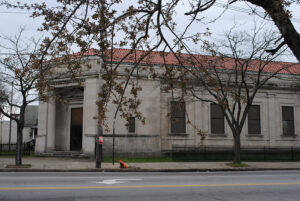2013 Five to Revive – Pulaski Library

Pulaski Library
1151 Hudson Avenue (southwest corner of Norton Street)
City of Rochester, Monroe County
Built in 1931, the Pulaski Library (originally the Hudson Avenue Branch Library) was the second permanent library constructed by the City of Rochester. Prior to its construction, the library system consisted of twelve temporary sites and the newly constructed permanent Monroe Avenue branch. The central library (Rundel Memorial Building) did not yet exist. The construction of a library on this site was further supported by completion of Benjamin Franklin High School directly across the street. A highly visible anchor in the 14621 neighborhood, the library is historically significant for its association with the growth and importance of the Polish community in Rochester’s North Side. During construction, it was proposed that the library be named in honor of Revolutionary War hero Brigadier General Casmir Pulaski, a native of Poland, who died in that conflict. On the 50th anniversary of this building, it was renamed “Pulaski Library” in honor of General Pulaski.
Listed in the State and National Registers of Historic Places, the Pulaski Library is architecturally significant as an intact representative example of Italian Renaissance style design applied to an important neighborhood civic building. It was designed by Rochester architects Herbert Bohacket and Lewis Brew, who were chose, in part, because of the success of their designs for the recently constructed Monroe Avenue branch library and East Side Presbyterian Church. The Italian Renaissance design of the building reflects other important civic buildings erected during this era, including the Eastman Theatre/School of Music and the Monroe Avenue Branch Library. The retrained, yet elegant appearance of the building is enhanced by its limestone construction and tile roof. In 1994, this library was closed when two library branches in the northeast area of the city were consolidated as a cost-saving move.
WHY SELECTED
A highly visible anchor in the 14621 neighborhood, the Pulaski Library is one of the most important civic buildings in the northeast quadrant of the city. Its exceptional historic and architectural significance, combined with outstanding materials and design make it an important candidate for revitalization after 30 years of vacancy.


